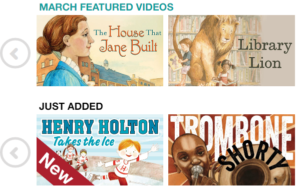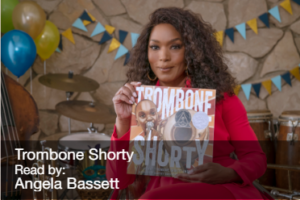- MN ABE Connect
- Archive
- Storyline Online: Not Just for Kids!
 May 3, 2021
May 3, 2021
Storyline Online: Not Just for Kids!
Marn Frank, ATLAS Literacy & STAR Coordinator Dena Hoel, ESL Teacher At a Networking Coffee Break during the Language & Literacy Conference, many wonderful instructional ideas were shared by reading teachers. One I found especially inspiring was Dena Hoel’s use of Storyline Online, SAG-AFTRA Foundation’s “award-winning children’s literacy website that streams videos featuring celebrated actors reading children’s books alongside creatively produced illustrations.”
At a Networking Coffee Break during the Language & Literacy Conference, many wonderful instructional ideas were shared by reading teachers. One I found especially inspiring was Dena Hoel’s use of Storyline Online, SAG-AFTRA Foundation’s “award-winning children’s literacy website that streams videos featuring celebrated actors reading children’s books alongside creatively produced illustrations.”
Dena selects one video book a week to anchor lessons, activities, and conversations for her ESL students. She graciously agreed to participate in an email interview to share more information about her decision and delivery. My questions and her answers are summarized below. If you have other questions, email Dena at [email protected].
Why did you choose this website?
 I have been using Storyline Online since we started teaching remotely a year ago. My ESL 1 students told me they really wanted to be able to read to their children in English and model the importance of reading. I chose this literacy website because it was responsive to their request, provides opportunities to see and hear a variety of children’s books, has the potential to build strong vocabularies, and prepares both parents and children for school and life success. My students have been very invested in Storyline Online throughout this pandemic year.
I have been using Storyline Online since we started teaching remotely a year ago. My ESL 1 students told me they really wanted to be able to read to their children in English and model the importance of reading. I chose this literacy website because it was responsive to their request, provides opportunities to see and hear a variety of children’s books, has the potential to build strong vocabularies, and prepares both parents and children for school and life success. My students have been very invested in Storyline Online throughout this pandemic year.
 The closed captioning or read-along option also occupies my students’ children during our virtual lessons and reduces the number of interruptions. Many of the children take part in the lessons and the whole family becomes engaged in learning and practicing English. This has improved attendance and my students are so proud when their children contribute to the class!
The closed captioning or read-along option also occupies my students’ children during our virtual lessons and reduces the number of interruptions. Many of the children take part in the lessons and the whole family becomes engaged in learning and practicing English. This has improved attendance and my students are so proud when their children contribute to the class!
What do you make available for children?
I created a special Google Classroom Topic called “For the Kids.” For example, my students can turn on GoNoodle for their children to get their wiggles out before class starts. Many other materials and website links for children are available to all teachers from Adult Education at Hawthorne.
What do you do before, during, and after lessons?
Before:
- I preview the week’s video book to make sure the actors are easy to understand and not reading aloud too fast. The book’s text dictates my lessons on vocabulary, word families, spelling, fluency, comprehension, writing, CASAS goals, and even math. I own print copies of most books available on Storyline Online and use them to plan my lessons and activities.
During:
- I begin by showing the book’s pages and we identify the title, author, and illustrator. We also talk about the pictures, bolded words, make predictions, and share connections to everyday life.
- For shorter books, I make a Google Doc of the text. We find or highlight words they already know, rhyming words or word families, pattern words (such as short vowels), sight words, verbs, etc. Sometimes we chunk longer key vocabulary words into syllables and figure out meanings and usage.
- For longer books, I share the book’s pages with a doc reader. I place a transparency over each page, so I can label the text and images. We work on fluency by reading parts of the book with accuracy, phrasing, expression, and at an appropriate rate.
- I play the video book at least twice a week during class (it gives my voice a rest). Sometimes I play it during our break so my students and their children can enjoy a beverage or snack while they watch and listen.
- After several book or video readings, we may develop a story retell or write a paragraph summary. We may further discuss topics related to the story that students have/had questions about.
After:
- My students can access all Storyline video books from our Google Classroom. By the end of the week, it is apparent who has been rereading and practicing fluency and pronunciation outside of class!
- My students also download youtube on their phones to practice Fry Phrases Set 1 and Set 2 outside of class.
What are some lesson examples based on a video book?
 Before reading Library Lion (GE K-2), we talked about:
Before reading Library Lion (GE K-2), we talked about:
- Key vocabulary: library, librarian, rules, stacks, office, story hour and difficult words: circulation, catalog, collection, overdue.
- The specifics of borrowing books, due dates, fines, and how to keep books safe at home.
- How you can also borrow CDs, DVDs, newspapers, and magazines from the library.
- How you can ask librarians or library staff for help in finding readable books or materials.
- How to use free mini-libraries located around the community (give and take).
After reading/watching Library Lion, we learned or reviewed the:
- Three punctuation marks that end sentences.
- Abbreviations and contractions used in the book.
- Use of upper- and lower-case i in words and sentences (library and lion vs. I read the book).
What is your end goal for your ESL 1 students?
I focus on teaching Reading Foundational Skills (RFS) 1-4, with an emphasis on English phonics patterns, Fry’s First 100 Words, and GE K-2/3 text fluency (and of course, text understanding). Before my ESL 1 students exit my class, I want them to progress to about a 3rd grade reading level. This qualifies them for placement in our program’s Reading 1 class. It also supports their readiness for higher-level skills, texts, conversations, and activities. Using Storyline Online as my lesson anchor makes our reading journey interesting, enjoyable, valuable, and is preparing my students and their children for school and life success!
Originally published 3/15/21

Newsletter Signup
Get MN ABE Connect—the official source for ABE events, activities, and resources!
Sign UpArticle Categories
- ABE Foundations/Staff Onboarding
- ACES/Transitions
- Adult Career Pathways
- Assessment
- CCR Standards
- Citizenship
- COVID-19
- Cultural Competency
- Digital Literacy/Northstar
- Disabilities
- Distance Learning/Education
- ELA
- Equity/Inclusion
- ESL
- HSE/Adult Diploma
- Listening
- Math/Numeracy
- Mental Health
- Minnesota ABE
- One-Room Schoolhouse/Multilevel
- Professional Development
- Program Management
- Reading
- Remote Instruction
- Science
- Social Studies
- Speaking/Conversation
- Support Services
- Teaching Strategies
- Technology
- Uncategorized
- Volunteers/Tutors
- Writing